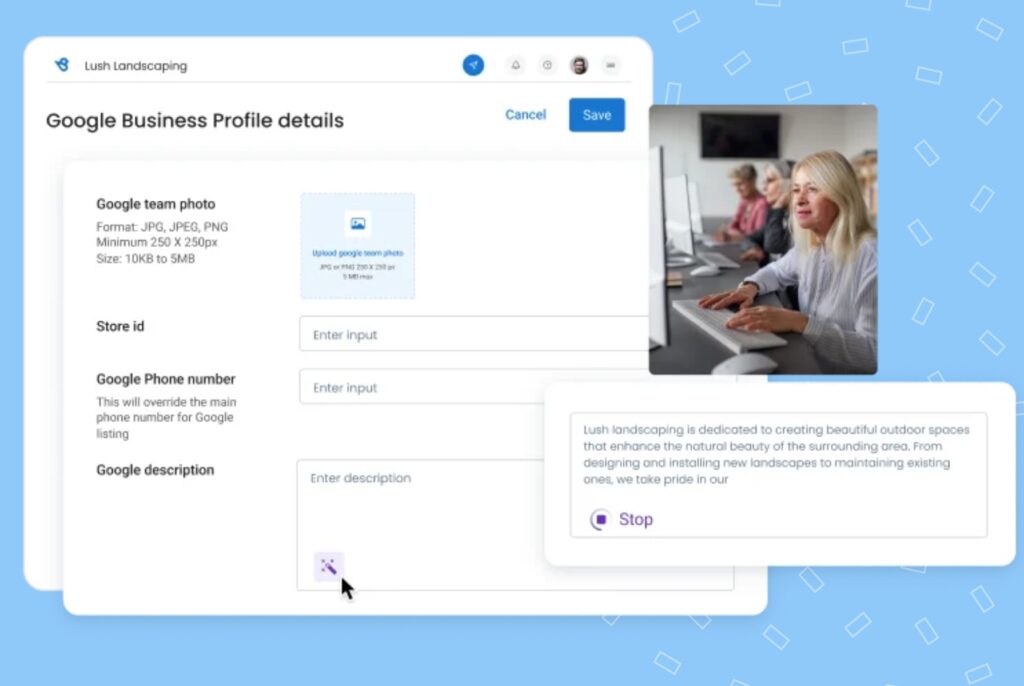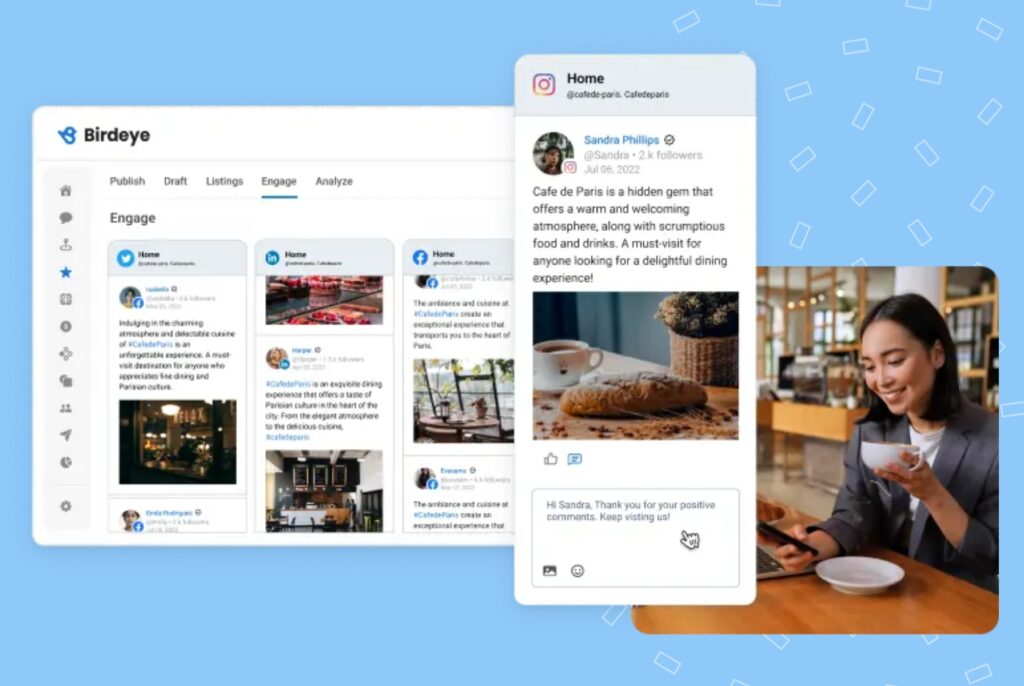Running an interior design business presents unique challenges, from sourcing materials and managing client expectations to navigating the ebb and flow of design trends.
This constant pursuit of innovation demands staying ahead of trends, adapting to evolving technologies, and ensuring the business is profitable. Juggling creative expression with the practicalities of project management and client interactions adds complexity.
Amidst these challenges, the last thing you want to waste your time on is unrealistic and time-consuming digital marketing strategies that give you no results.
This blog stands apart as a non-overwhelming guide, no-fluff, just actionable insights, offering a streamlined approach to interior design marketing.
From leveraging modern approaches like virtual tours to mastering collaborative content creation, this article guides you through strategic steps designed to innovate, captivate, and elevate your marketing game.
Marketing for interior designers involves online marketing strategies like social media marketing, networking, and targeted advertising, and offline approaches like networking and attending events.
In this blog, we guide you on how to:
- Apply the ten ways to market your interior design business
- Implement seven interior design ad ideas
- Top five SEO tips to help you be found online
- Leverage Birdeye’s Listing platform
Table of contents
- How to do marketing for an interior design business
- 10 digital marketing strategies for interior designers
- 1. Elevate your social media engagement strategy
- 2. Master your SEO strategy
- 3. Prioritize collaborative content creation
- 4. Make interactive website designs
- 5. Show success stories with client testimonials
- 6. Do visual storytelling through content marketing
- 7. Captivate audiences through innovative video marketing
- 8. Have a targeted email marketing strategy
- 9. Stay ahead through continuous experimentation
- 10. Build an impressive portfolio of work
- 8 interior designer advertising ideas
- How to grow your interior design business?
- 5 SEO tips for interior designers to enhance online visibility
- How to leverage social media for interior design marketing?
- FAQs on marketing for interior designers
- Effective marketing for interior designers with Birdeye
How to do marketing for an interior design business
Marketing for interior designers is a strategic and creative effort to promote their services to attract potential clients and solidify their online reputation management.
This approach includes online and offline strategies such as building a professional website, leveraging the business’s social media profiles, showcasing a portfolio, and actively networking.
10 digital marketing strategies for interior designers
Here are the ten strategies for effective digital marketing for interior designers:
- Social media marketing
- Search engine optimization
- Content creation
- Interactive website designs
- Share successful client case studies
- Request reviews
- Do visual brand storytelling
- Promote content through video marketing
- Email marketing
- Showcase an impressive online portfolio
In the following section, we discuss how you can implement all these online marketing tactics in your brand strategy:
1. Elevate your social media engagement strategy
Marketing for interior design businesses thrives on visual appeal and engagement. So, social media provides a direct channel to showcase creativity and build a loyal following.
Utilize platforms like Instagram, Pinterest, and Houzz to allow you to share visually appealing content, connect with the target audience, and participate in design conversations.
How can interior designing businesses implement this social media engagement strategy?
- Regularly post high-quality images of completed projects.
- Engage with followers through comments, likes, and responding to messages.
2. Master your SEO strategy
Optimizing website content, meta tags, and images to rank higher on search engines are a few of the tools for SEO that make this digital marketing strategy for interior designers very easy to be found wherever customers search for you.
How can interior designing businesses implement this SEO strategy?
- Ensure your interior design business is claimed and verified on Google Business Profile.
- Conduct keyword research and incorporate relevant keywords naturally into website content.
- Optimize images with descriptive alt text and file names.
Pro tip: Leverage Birdeye’s business Listing management platform to show up where your customers search

3. Prioritize collaborative content creation
Content creation is a long-term goal. So, partnering with influencers, bloggers, or other professionals to co-create content helps expand reach and leverage their audiences.
This online marketing tactic for interior design businesses amplifies the reach as they tap into new audiences and build credibility through trusted recommendations.
How can interior designing businesses implement this collaborative content creation strategy?
- Explore diverse content formats such as joint blog posts, Instagram takeovers, or collaborative design projects.
- Define the goals of your collaborative content strategy, whether it’s expanding reach, tapping into new demographics, or simply showcasing creative appeal.
4. Make interactive website designs
Creating a website with interactive elements, such as virtual tours, 3D visualizations, or design quizzes, can help you better engage visitors and enhance the user experience.
This captivates potential clients, encourages longer website visits, and sets the marketing for interior designers apart in a visually-driven industry.
How can interior designing businesses implement this interactive website design strategy?
- Incorporate interactive elements that showcase the design process or allow visitors to envision their space.
- Ensure mobile responsiveness for a seamless experience on various devices.
5. Show success stories with client testimonials
Promising positive client testimonials on the website creates trust and provides social proof, which works wonders.
Pro tip: Do you know the 30 testimonial questions your business should ask your customers?
How can interior designing businesses implement this client testimonial showcase strategy?
- Request testimonials from satisfied clients and display them on a dedicated page.
- Use excerpts or quotes in digital marketing materials to highlight positive experiences.
6. Do visual storytelling through content marketing
To tell compelling stories, create engaging blog content that combines visual elements, such as before-and-after photos, mood boards, or project walkthroughs.
Appealing to the visual nature of interior design keeps the audience engaged and provides valuable insights, which is a great way to market your interior design business.
Pro tip: Turn negative customer reviews into positive ones by addressing feedback promptly.
How can interior designing businesses implement this visual storytelling?
- Share project stories, design inspiration, and industry insights.
- Use high-quality images.

7. Captivate audiences through innovative video marketing
Incorporating video content, such as project walkthroughs, design process time-lapses, or client testimonials, captivates the audience and provides a dynamic view. This adds a personal touch to interior design marketing.
How can interior designing businesses implement this video marketing strategy?
- Create short and engaging videos that showcase design processes and completed projects.
- Share videos on social media platforms, websites, and email newsletters.
Recommended read: 4 Key tips to getting more Houzz reviews
8. Have a targeted email marketing strategy
Sending personalized and targeted emails to a segmented audience and sharing updates, promotions, and exclusive content are great digital marketing hacks for interior designers.
This nurtures client relationships, keeps the brand in mind, and can lead to repeat business and referrals.
How can interior designing businesses implement this email strategy?
- Segment the email list based on client preferences, location, or engagement levels.
- Tailor email content to the specific interests and needs of each segment.
9. Stay ahead through continuous experimentation
An underrated hack for marketing for an interior design company is to position yourself as a trendsetter. Do this by keeping design work fresh and appealing to attract clients seeking the latest trends in interior design.
How can your interior designing business implement this strategy?
- Actively participate in relevant conferences, workshops, and seminars.
- Promote a culture of continuous education within your design team by organizing regular knowledge-sharing sessions or encouraging team members to attend relevant training programs.
10. Build an impressive portfolio of work
Brand reputation management should be your top marketing priority. And this happens when you showcase your brilliance with an innovative online portfolio.
Continuously update and optimize your online portfolio with high-quality images, detailed project descriptions, and a strong storytelling narrative.
How can interior designing businesses implement this portfolio enhancement strategy?
- Regularly update the portfolio with new projects and design styles.
- Include comprehensive project descriptions by highlighting challenges, solutions, and client satisfaction.
8 interior designer advertising ideas
Here are seven additional interior designer advertising ideas that complement the strategies mentioned earlier:
1. Review management
Incorporating review management into your interior design advertising strategy enhances your online reputation and attracts more clients. After completing a successful project, ask satisfied clients to leave reviews on your Google Business Profile page.
Use Birdeye’s automated review request feature to streamline the process.
2. Collaborative brand partnerships
Forge partnerships with complementary brands, such as furniture manufacturers or home decor retailers, for joint advertising campaigns or co-branded events.

3. Interactive design workshops
Host interactive design workshops or webinars, showcasing your expertise and engaging potential clients in the design process.
4. Limited-time promotions
Create limited-time promotions or exclusive discounts for your interior design services, encouraging prospective clients to take advantage of special offers.
5. Innovative print advertisements
Design eye-catching and innovative print advertisements for local magazines or community publications to reach a broader audience.
6. Virtual reality (VR) showcases
Explore virtual reality technology to create immersive showcases of your design projects, providing potential clients with a unique and memorable experience.

7. Podcast sponsorships
Sponsoring or participating in design-focused podcasts is a highly effective customer acquisition strategy. Due to its focus on an audience interested in home improvement, decor, and interior design, this approach enables you to target a highly specific and relevant customer base.
8. Art installations and exhibits
Collaborate with local art galleries or exhibition spaces to display art installations showcasing your design concepts, attracting attention from art enthusiasts and potential clients.
Integrate these ideas about advertisements for interior designers into your overall online marketing strategy to diversify your reach and capture the attention of different audience segments.
18 Ways of Marketing with Interior Designers
Want to see the impact of Birdeye on your business? Watch the Free Demo Now.
How to grow your interior design business?
Digital marketing for interior designers requires you to be creative and adapt to new strategies. You should start seeing tangible results once you follow all the 18 ways mentioned above.
Apart from that, to grow your interior design business, here is a step-by-step process:

Step 1. Develop a strategic interior design marketing plan tailored to your business goals and target audience.
Step 2. Establish a strong online presence for your interior design company through a professional website and active engagement on social media platforms.
Step 3. Cultivate strategic partnerships within the design community and related industries to broaden your network and increase collaborative opportunities.
Step 4. Define and communicate a unique selling proposition (USP) that sets your marketing for interior design companies apart from others.
5 SEO tips for interior designers to enhance online visibility
To enhance the visibility of your interior design business, you must implement these top 5 local business SEO tips:
1. ✅ Tailor your website content with location-specific keywords related to interior design services in your area.
This enhances visibility in local searches, especially when potential clients search for keywords like “interior design professionals near me” or “best interior designers in my area.”
2. ✅Use descriptive alt text for images on your website, incorporating relevant keywords.
This not only enhances accessibility but also improves the chances of your design projects appearing in image searches, increasing overall visibility.
3. ✅ Boost relevance by creating blog posts on design trends, inspiration, and project showcases.
This establishes your expertise and provides valuable content for search engines to index, increasing your website’s relevance for design-related queries.
4. ✅ Implement structured data markup to highlight specific details about your design projects, such as project type, style, and materials used.
This helps search engines better understand and categorize your content.
5. ✅ Ensure your website is optimized for mobile devices, as search engines favor mobile-friendly sites.
Strategizing marketing for interior design involves aligning promotional efforts with competitive pricing.
How to leverage social media for interior design marketing?
Social media marketing for interior designers uses platforms like Instagram, Pinterest, and Houzz to visually promote design services, engage with a target audience, and build brand awareness.
This approach offers a cost-effective means of promoting services. The visual nature of social media allows designers to explore and incorporate the latest design trends, showcase their work globally, and convey their brand personality through visual content.
However, challenges include standing out in a visually saturated space, consistent engagement demands, and the need for a thoughtful selection of platforms to align with the target demographic.
To help you leverage social media for interior design marketing optimally, here are nine tried-and-tested strategies of successful interior design companies:
- Establish a regular posting schedule to keep your audience engaged.
- Encourage interaction with polls, quizzes, live Q&A sessions, tutorials, virtual events, and contests.
- Respond promptly to comments and direct messages on your social media profiles.
- Share behind-the-scenes glimpses of your work, team, or design process. This humanizes your brand.
- Encourage users to create content related to your brand.
- Create content that is shareable and resonates with your audience.
- Use social media analytics to understand what content performs best.
- Participate in relevant social media trends and challenges.
- Tailor your content to your specific audience.

FAQs on marketing for interior designers
Technology aids in 3D modeling, virtual reality tours, and project management. Integrating tech enhances client presentations, streamlines processes, and improves communication.
Stay updated through industry publications, forums, and design events to incorporate the latest trends into your work.
Interior designers market through social media, websites, local events, and strategic SEO. Influencer collaborations and word-of-mouth referrals are impactful.
Promote your design through websites, social media, blogs, local events, promotions, and testimonials. Networking and collaborating amplify promotion efforts.
Advertise on Google Ads, social media, interior design review sites, design websites, local magazines, and community bulletin boards. Tailor ads to target audience preferences.
Effective marketing for interior designers with Birdeye
Now that you know the 18 ways to market your interior design business and the steps to grow your brand, elevate your brand experience with Birdeye Listing.
Designed with AI-powered keyword capabilities, Birdeye’s business Listing management ensures your interior design services details stand out when potential clients search on Google.
Click on the banner to schedule an appointment to learn how adding this to your CRM can strengthen your customer experience.

Originally published









